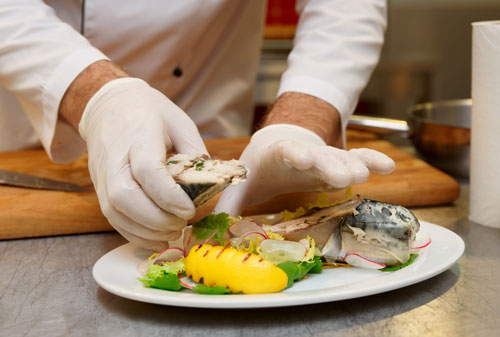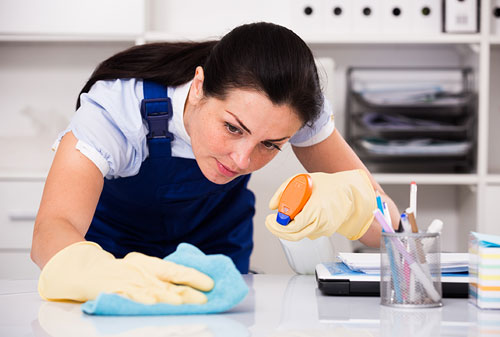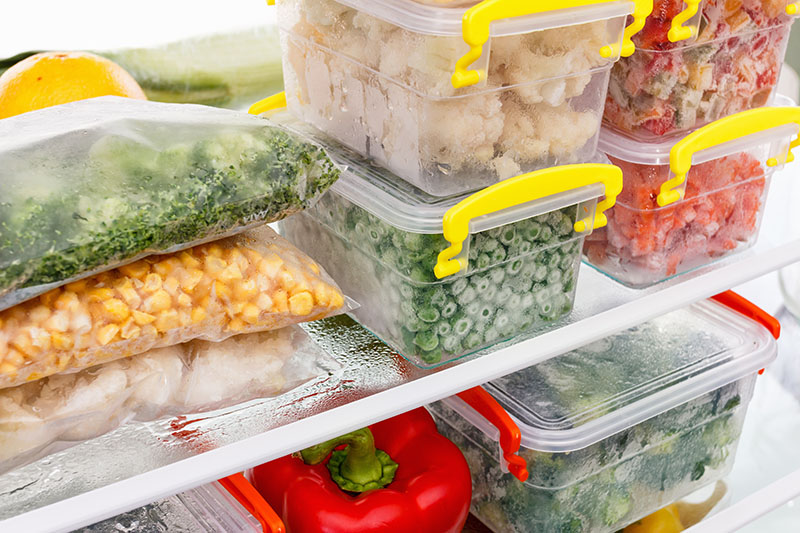




It is estimated that each year in the UK around a million people suffer a food borne illness. Of these, it is estimated that around 20,000 people receive hospital treatment and there are around 500 deaths.
The Food Standards Agency (FSA) was established by the Food Standards Act 1999. The FSA is an independent department within the Welsh Government which operates across Wales, England and Northern Ireland to protect public health. The Agency's main aim is to protect the public in relation to food. This act provides the power to take action at any time in relation to food production and supply where that action is in the interest of users.
The main responsibilities of this act are to:
The Food Hygiene Regulations 1995 act states that if any early years provision prepares food (including snacks such as cheese and crackers), it must comply with these regulations, which include:
As well as this, the act states that a good knowledge is required with regard to using chopping boards safely, that a separate sink is required for food preparation and hand washing, and also that there should be at least one qualified person present, who has a Basic Food Hygiene certificate.
Employers and workers have a responsibility to ensure that they have good food hygiene standards. This is essential in order to prevent food poisoning, and to ensure that the food served is safe to eat.
In order to ensure good hygiene, it is essential to consider:
Food safety is controlled by complying with hygiene and food standards. Employers and workers need to ensure that procedures are in place for food safety, and use the appropriate legislation as well as the workplace's relevant policies.
According to the law, it is essential to note the requirements with regard to food labelling and packaging in order to protect people, and to ensure that they have the correct information based on diet or allergies. In order to avoid harm, correct information should be provided about food contents, and food allergens must be handled and controlled appropriately.
The procedures in place for controlling food safety that are based on the principles of Hazard Analysis and Critical Control Points (HACCP) create a system that helps to identify food hazards.
HACCP includes:
When handling food, personal hygiene is essential. Before preparing food, the following should be done:
There are four types of hazards to be considered when preparing food:
Microbiological: referring to harmful bacteria, yeast, mould and viruses.
Chemical: when chemicals enter foods, e.g. food contact materials, cleaning products, pest control chemicals.
Physical: when objects enter foods e.g. glass, packaging, jewellery, and so forth.
Allergens: referring to the risk associated with cross-contamination.
Amcangyfrifir bod tua miliwn o bobl yn y DU yn cael salwch a gludir gan fwyd bob blwyddyn. O blith y rheini amcangyfrifir bod 20,000 yn cael triniaeth mewn ysbyty a bod 500 o farwolaethau.
Sefydlwyd Asiantaeth Safonau Bwyd (ASB) yn sgil y Ddeddf Safonau Bwyd 1999. Mae’r ASB yn adran annibynnol o fewn Llywodraeth Cymru sydd yn gweithredu ar draws Cymru, Lloegr a Gogledd Iwerddon er mwyn diogelu iechyd y cyhoedd. Prif nod yr Asiantaeth yw gwarchod y cyhoedd mewn perthynas â bwyd. Mae’r ddeddf yn rhoi’r pŵer i weithredu er budd y defnyddiwr ar unrhyw adeg yn y broses o gynhyrchu a chyflenwi bwyd.
Prif gyfrifoldebau’r ddeddf hon yw:
Mae’r ddeddf Rheoliadau Hylendid Bwyd 1995 yn nodi os oes unrhyw ddarpariaeth blynyddoedd cynnar sy’n paratoi bwyd (gan gynnwys snac megis caws a chracer), mae angen cydymffurfio â’r rheoliadau hyn, sy’n cynnwys:
Yn ogystal â hyn, mae’r ddeddf yn nodi bod angen gwybodaeth dda ar sut i ddefnyddio bwrdd torri yn ddiogel, bod angen sinc ar wahân ar gyfer paratoi bwyd a golchi dwylo, a hefyd bod angen o leiaf un person yn bresennol sydd wedi cymhwyso, a gyda thystysgrif Hylendid Bwyd Sylfaenol.
Mae gan gyflogwyr a gweithwyr gyfrifoldeb i sicrhau fod ganddynt hylendid bwyd da. Mae hyn yn hanfodol ar gyfer atal gwenwyn bwyd, ac i wneud y bwyd maent yn ei weini yn ddiogel i’w fwyta.
Ar gyfer hylendid da, mae’n hanfodol cymryd i ystyriaeth:
Mae diogelwch bwyd yn cael ei reoli drwy gydymffurfio â hylendid, a safonau bwyd. Mae angen i gyflogwyr a gweithwyr sicrhau bod gweithdrefnau yn eu lle ar gyfer diogelwch bwyd ar waith, a dilyn y deddfau priodol yn ogystal â pholisïau perthnasol y gweithle.
Yn ôl y gyfraith, mae’n hanfodol nodi beth sy’n ofynnol ar labeli a phecynnau bwyd er mwyn diogelu pobl, a sicrhau eu bod yn cael yr wybodaeth gywir yn seiliedig ar ddiet neu alergeddau. Er mwyn arbed niwed, mae angen darparu gwybodaeth gywir am gynnwys y bwyd, yn ogystal â thrin a rheoli alergenau bwyd yn briodol.
Mae’r gweithdrefnau rheoli diogelwch bwyd ar waith sydd wedi eu seilio ar egwyddorion Dadansoddi Peryglon a Phwyntiau Rheoli Critigol (Hazard Analysis and Critical Control Points neu HACCP), yn system sydd yn help i adnabod peryglon bwyd.
Mae HACCP yn cynnwys:
Wrth ymdrin â bwyd, mae hylendid personol yn hanfodol.
Cyn paratoi bwyd, mae angen gwneud y canlynol:
Mae pedwar math o beryglon sydd angen cymryd i ystyried wrth baratoi bwyd:
Microbiolegol: yn cyfeirio at facteria niweidiol, burum, llwydni a firws.
Cemegol: pan fydd cemegau yn mynd i mewn i fwyd, e.e. deunyddiau cyswllt bwyd, cynhyrchion glanhau, cemegau rheoli pla.
Ffisegol: pan fydd pethau yn mynd i mewn i fwyd e.e. gwydr, pecynnu, gemwaith, ac yn y blaen.
Alergenau: yn cyfeirio at y risg sy’n gysylltiedig â thraws-halogi.
| QuestionCwestiwn | Your ResponseEich Ymateb | Suggested ResponseYmateb Awgrymedig |
|---|

Kitchens that undertake food preparation must be clean. Effective cleaning eliminates bacteria, and helps to prevent harmful bacteria from spreading to food.
In order to kill bacteria, surfaces, equipment and utensils must be washed in warm water with detergent and disinfectant. There are many different cleaning and disinfecting products available so the manufacturer's directions should be read carefully in order to use the product correctly. In order to kill bacteria properly, the product will normally need to be left on the surface for a short period to work.
Employers have a duty to meet the 'Personal Protective Equipment at Work Regulations 1992' with regard to the provision and use of personal protective equipment.
Personal Protective Equipment (PPE) is used to protect users from the health risks associated with the workplace. As kitchens are hot, busy and dangerous areas to work, where the oven, open fires and sharp knives add to the risk of harm, it is essential to wear personal protection equipment.
The type of protective equipment that should be worn when working in a kitchen include the following:
Mae’n rhaid i geginau sy’n paratoi bwyd fod yn lân. Mae glanhau effeithiol yn cael gwared ar facteria, ac yn help i atal bacteria niweidiol rhag lledaenu i fwyd.
Er mwyn lladd bacteria, mae angen golchi arwynebau, offer a chyfarpar gyda dŵr cynnes, sebon a diheintydd. Mae sawl cynnyrch glanhau a diheintio ar gael, felly mae angen sicrhau eich bod yn darllen cyfarwyddiadau’r cynhyrchwyr yn ofalus er mwyn defnyddio’r cynnyrch cywir. Ar gyfer lladd bacteria yn iawn bydd fel arfer angen gadael y cynnyrch ar yr arwyneb am ychydig i weithio.
Mae gan gyflogwyr ddyletswydd i fodloni’r ‘Rheoliadau Cyfarpar Diogelu Personol yn y Gwaith 1992’ o ran darparu a defnyddio cyfarpar diogelu personol.
Mae cyfarpar diogelu personol (Personal Protective Equipment - PPE) yn cael ei ddefnyddio i ddiogelu’r defnyddiwr rhag risgiau i iechyd yn y gweithle. Gan fod ceginau yn ardaloedd poeth, prysur a pheryglus i weithio ynddynt, lle mae popty, tannau agored a chyllyll miniog yn ychwanegu at risg o niwed mae gwisgo cyfarpar diogelu personol yn hanfodol.
Dyma’r math o gyfarpar diogelu y dylid ei wisgo wrth weithio mewn cegin:
Drag the words to the correct spaces.
Llusgwch y geiriau i’r bylchau cywir.
You scored … out of . Move some of the terms around to try to improve your score.
Well done. You scored … out of .
You scored … out of . Click reset to try the activity again.
You scored … out of . Move some of the terms around to try to improve your score.
Well done. You scored … out of .
You scored … out of . Click reset to try the activity again.
Eich sgôr yw … allan o . Symudwch rhai o'r termau o gwmpas i geisio gwella eich sgôr.
Da iawn. Eich sgôr yw … allan o .
Eich sgôr yw … allan o . Cliciwch ‘ailosod’ er mwyn rhoi cynnig arall ar y gweithgaredd.
Eich sgôr yw … allan o . Symudwch rhai o'r termau o gwmpas i geisio gwella eich sgôr
Da iawn. Eich sgôr yw … allan o .
Eich sgôr yw … allan o . Cliciwch ‘ailosod’ er mwyn rhoi cynnig arall ar y gweithgaredd.

Food poisoning is often caused by bacteria from food that has been incorrectly stored, prepared or cooked.
Food that has been contaminated with bacteria associated with food poisoning may look, smell and taste normal. If the food is not stored correctly, the bacteria within can multiply to hazardous levels.
Good hygiene is essential when storing food.
Fruit and vegetables need to be used as soon as possible after their purchase, and any showing signs of deterioration should be thrown. Vegetables need to be stored in the dark to prevent them from deteriorating.
If possible, raw foods such as meat and poultry should be stored in a separate refrigerator to dairy products and cooked meats.
Kitchen waste, and food waste, should be disposed of promptly, hygienically and appropriately, and adequate facilities must be provided for this purpose in order to avoid attracting rodents, insects and birds. When disposing of food, the following should be done:
Mae gwenwyn bwyd yn aml yn cael ei achosi gan facteria o fwyd sydd wedi ei storio, ei baratoi neu ei goginio yn anghywir.
Gall bwyd sydd wedi'i halogi â bacteria gwenwyn bwyd edrych, arogli a blasu'n normal. Os na chaiff bwyd ei storio'n gywir, gall y bacteria ynddo luosi i lefelau peryglus.
Mae hylendid da yn hanfodol pan yn storio bwyd.
Mae angen defnyddio ffrwythau a llysiau cyn gynted â phosib ar ôl eu prynu, a thaflu y rhai sydd yn dangos arwyddion o ddirywio. Mae angen storio llysiau yn y tywyllwch i’w hatal rhag dirywio.
Os yn bosib, mae angen storio bwydydd amrwd megis cig a dofednod mewn oergell ar wahân i gynnyrch llaeth a chig sydd wedi ei goginio.
Mae angen gwaredu gwastraff cegin, a gwastraff bwyd yn brydlon, yn hylan ac yn briodol, ac mae’n rhaid cael cyfleusterau digonol ar gyfer hyn i osgoi denu plâu megis cnofilod (rodents), pryfed ac adar. Wrth waredu â bwyd, dylid:
Complete the activity below.
Cwblhewch y gweithgaredd isod.